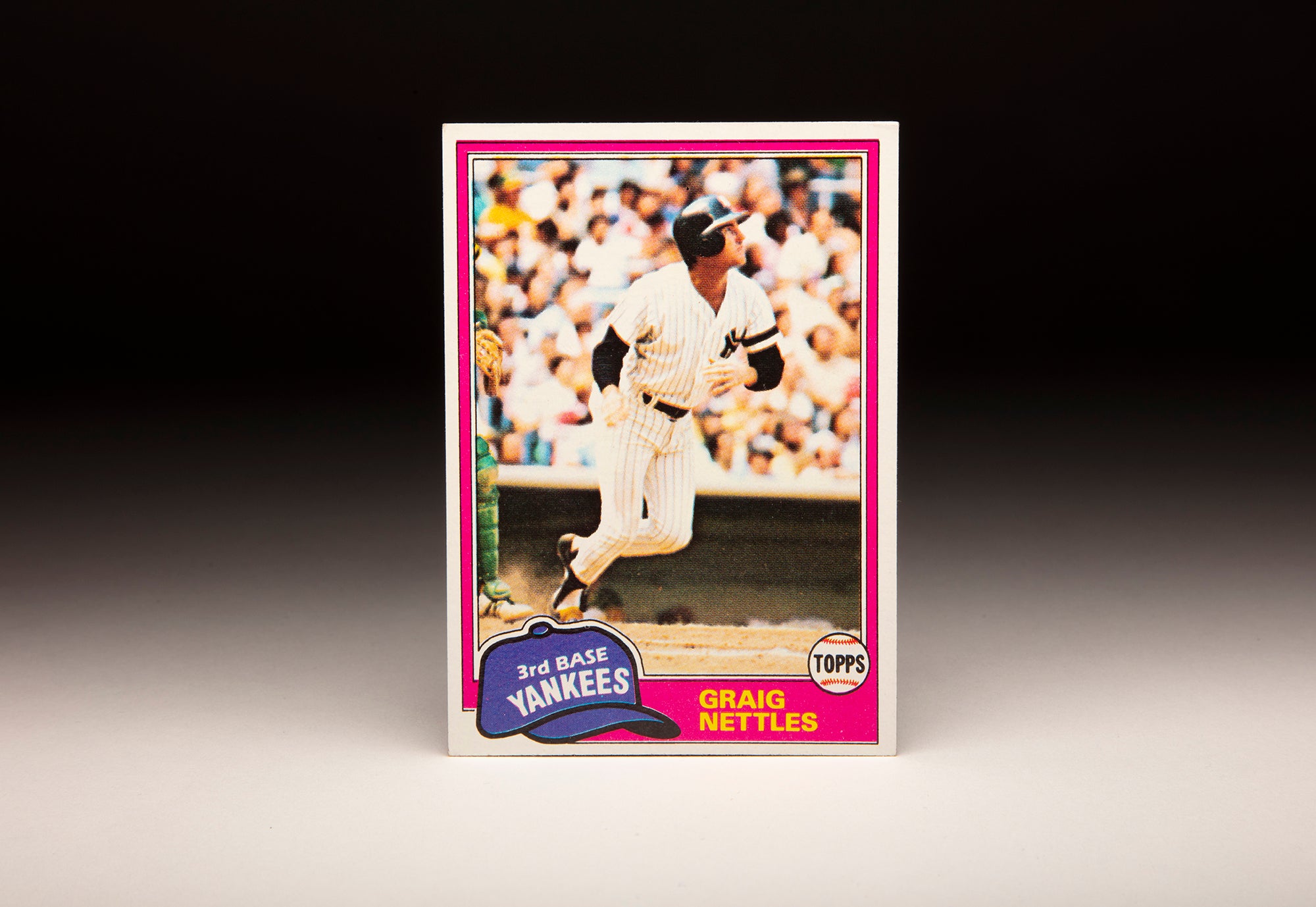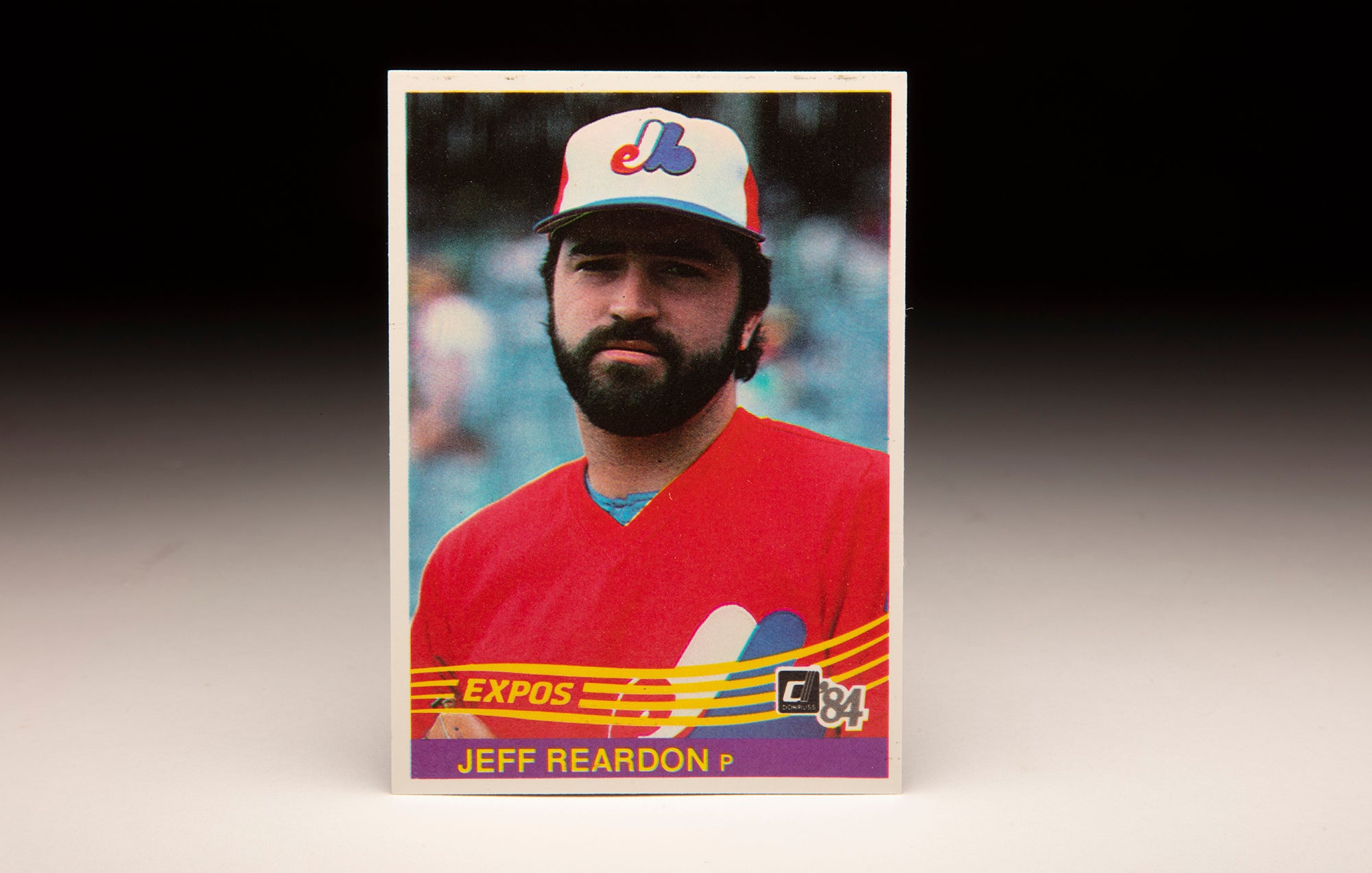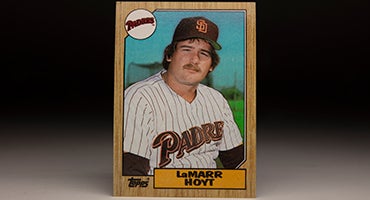- Home
- Our Stories
- #CardCorner: 1984 Donruss Luis Salazar
#CardCorner: 1984 Donruss Luis Salazar
When Luis Salazar played his last big league game in 1992, only seven Venezuelans had appeared in more MLB contests.
It was a testament to Salazar’s determination – a trait that served him well when he nearly lost his life in a Spring Training game almost 20 years after his retirement.
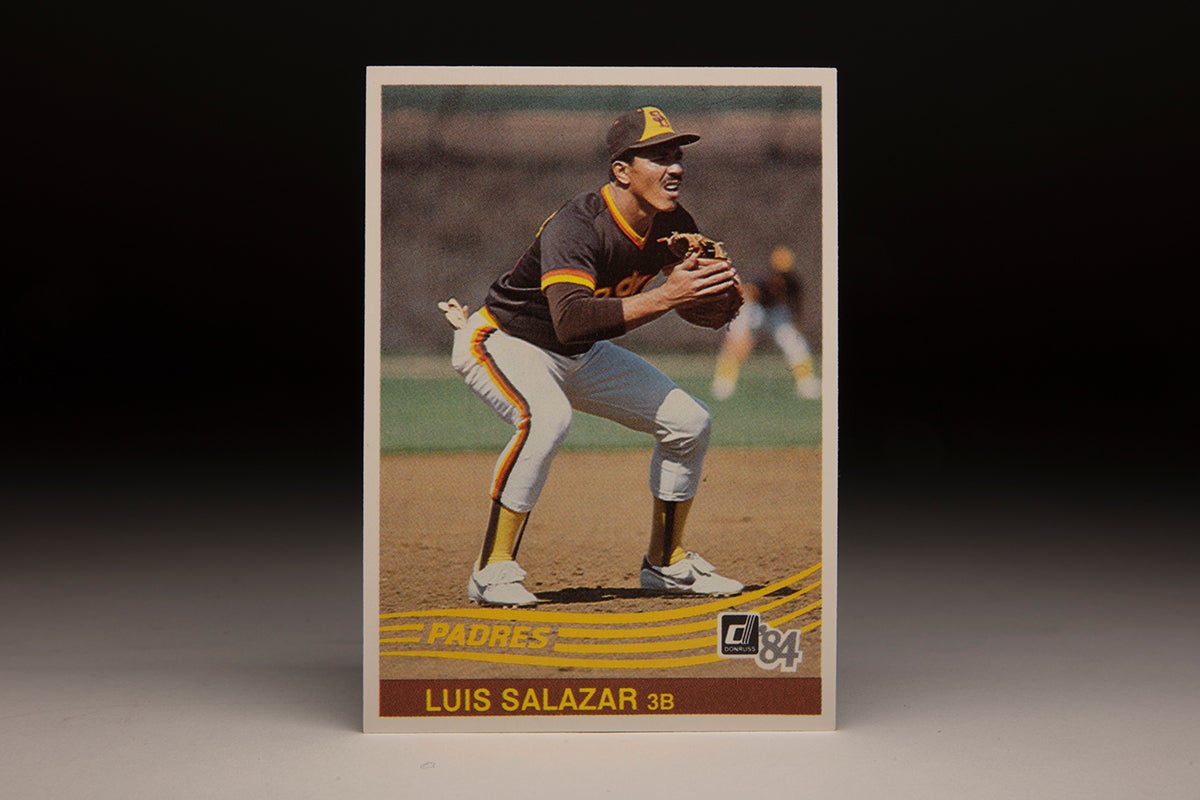
Born Luis Ernesto Salazar on May 19, 1956, in Barcelona, Venezuela, he helped support his family as a teenager by delivering milk and bread to nearby homes and later selling empanadas at the local ballpark. He signed his first pro contract with the Royals on Nov. 29, 1973, but was released during the 1974 season after playing in just two games with the Royals’ Gulf Coast League affiliate.
Salazar spoke little English, and the language barrier created an almost impossible hurdle.
“It was hard when I was with Kansas City,” Salazar told the Buffalo News in 1979. “I was the only Latin on the club. Everything seemed hard. After they let me go, I just wanted to quit the game and get back home.”
The Pirates invited Salazar to a tryout camp soon after he was released but Salazar decided to return to Venezuela. Former big leaguer Pompeyo Davalillo, however, took Salazar under his wing and helped rebuild his confidence. He played winter ball in Venezuela that year and was ready for another chance in the United States.
“Kansas City tried to get me back,” Salazar told the Buffalo News, “but I didn’t want to go there again.”

Instead, Salazar signed with the Pirates, who assigned him to their New York-Penn League team in Niagara Falls for the 1976 season. There, Salazar met Phil Scaffidi, a high school basketball and baseball star from Buffalo, N.Y., who had been drafted by the Pirates in 1974. Scaffidi spoke Spanish and befriended Salazar, helping him make the adjustment to the pro game in North America.
“(Salazar) couldn’t speak English very well but I knew he was intelligent,” Scaffidi told the Buffalo News in 1979. “I didn’t feel sorry for him or anything like that. I just wanted to help him.”
Scaffidi left baseball after the 1976 season and concentrated on basketball, where he starred at Niagara University. Diagnosed with cancer in 1978, Scaffidi passed away on March 23, 1980. His valiant struggle made headlines across the country.
“He treated me like a brother,” Salazar said of Scaffidi. “We used to talk about things and he used to help me all the time. When we went out, Phil would help me order food and things like that. It meant a lot to me.”
Salazar hit .238 in 42 games in Niagara Falls while playing both infield and outfield, then was promoted to Class A Salem of the Carolina League in 1977. He hit .270 with 11 homers and 48 RBI that season and then returned to Salem in 1978, where he batted .292 to crack the Top 10 of the Carolina League batting average rankings.

In 1979, the Pirates assigned Salazar to Double-A Buffalo, where – aided by the War Memorial Stadium right field wall that was just 301 feet from home plate – he hit 27 homers, 12 more than his three previous seasons combined – while batting .323 with 86 RBI and 21 steals. He also spent most of the season in center field.
“He would be having a good year in any park,” Buffalo manager Steve Demeter said. “Success breeds confidence. That is what happened to Luis. Now he knows he can do it.”
Salazar also got married that year and credited his wife, Graciela, as being a stabilizing factor. Suddenly, Salazar found himself on the fast track to the big leagues.
“The kind of season Luis is having has stamped him as a definite prospect for the major leagues,” Pittsburgh scouting director Murray Cook told the Buffalo News. “If he keeps (hitting) as he progresses at each level, eventually we’ll want him in Pittsburgh.”
Salazar would find himself in the big leagues in 1980 – but not in Pittsburgh. After continuing to hit well in Triple-A Portland with the Pirates’ top minor league team in 1980, Salazar was dealt to the Padres on Aug. 5, 1980, along with fellow prospect Rick Lancellotti in exchange for Kurt Bevacqua and Mark Lee. Bevacqua was expected to give the Bucs a boost off the bench but hit just .163 in 22 games and would finish his career as Salazar’s teammate in San Diego from 1982-85.
Salazar, meanwhile, was a revelation for the Padres – hitting .337 in 44 games after his Aug. 15 debut, taking over as San Diego’s starting third baseman and earning a roster spot when Jerry Turner was placed on the disabled list with a broken left hand.
By the spring of 1981, Salazar was entrenched at third base.
“Salazar is a tremendously gifted outfielder,” Padres manager Frank Howard told the Times-Advocate of Escondido, Calif., “but right now he fills a need for us at third base.”

Salazar appeared in all but one of the Padres' 110 games during the strike-shortened 1981 season, batting .303 with 121 hits (eighth in the National League) while totaling 189 assists at third base (fifth in the NL). But in 1982, Salazar’s average dropped to .242 while his errors at third base increased to 26, the worst mark in the league. Salazar did drive in 62 runs and stole 32 bases, which helped him secure his third straight Opening Day start at third base in 1983.
Salazar was hitting around the .300 mark in early May but had just two RBI, prompting manager Dick Williams to begin platooning the right-handed hitting Salazar with the lefty-swinging Tim Flannery. Salazar finished the year batting .258 with 14 homers, 45 RBI and 24 steals in 134 games. Williams, however, was looking for more offense.
On March 30, 1984, the Padres dealt pitcher Dennis Rasmussen and a minor leaguer to the Yankees in exchange for 39-year-old Graig Nettles. The Padres had tried to acquire Nettles the year before – and getting the veteran third baseman now meant Salazar was moving to a bench role.
“I’m the kind of guy that when I get paid good money I want to earn it and I want to play as much as I can,” Nettles told United Press International after the trade.
Nettles would hit 20 homers in 124 games that year while providing the veteran attitude that Williams coveted. Salazar was effective off the bench, hitting .241 in 93 games as the Padres won their first NL West title. Appearing in the postseason for the first time, Salazar had a triple in five at-bats in San Diego’s win over Chicago in the NLCS then went 1-for-3 in four games as the Padres fell to Detroit in the World Series.
The Padres’ loss in the Fall Classic was largely due to ineffective starting pitching, and general manager Jack McKeon decided to address this in the offseason. On Dec. 6, 1984, he acquired former Cy Young Award winner LaMarr Hoyt from the White Sox in exchange for Ozzie Guillén, Tim Lollar, Bill Long and Salazar.
Guillén was the centerpiece of the return for Hoyt. But White Sox general manager Roland Hemond indicated that acquiring Salazar was also a key to parting with Hoyt.

Salazar appeared in 84 games in the outfield in 1985 and also saw significant time at third base, hitting .245 with 10 homers, 45 RBI and 14 steals in 122 games. But in the waning days of the season, Salazar suffered a left knee injury – one that would sideline him for all but four games in 1986.
“It was a routine foul ball behind the dugout,” Salazar told the Post-Crescent of Appleton, Wisc., during a rehabilitation assignment in July of 1986 as he was recovering from surgery to repair his anterior cruciate ligament. “I hit the tarp and it felt like I broke my leg. The doctors say the knee will never be 100 percent again.”
The White Sox released Salazar on Dec. 19, 1986, and he re-signed with the Padres on April 2, 1987. He reprised his bench role of 1984 that season, batting .254 in 84 games while playing at every position except second base and catcher – even appearing in two games as a pitcher, allowing two hits and one run over two innings.
Becoming a free agent after the season, Salazar signed a minor league deal with the Tigers on Feb. 20, 1988, and made the team out of Spring Training after batting .418 with team highs in home runs (three) and RBI (17) during the exhibition season. He would play in 130 games that year, getting 113 starts – mostly in the outfield early in the season and then regularly at shortstop in September after Alan Trammell was sidelined with a groin injury. Salazar hit .270 with 12 homers and 62 RBI – then found himself back in San Diego for a third stint when the Padres acquired him on March 23, 1989, in exchange for Mike Brumley – part of a flurry of three trades in one day for the Tigers.
Salazar hit .268 in 95 games off the bench for San Diego before being dealt to the Cubs on Aug. 30 in a deal just before postseason rosters were set. The Cubs were making a push for the NL East title and were looking for an upgrade at third base – and Salazar gave them a boost by hitting .325 with 12 RBI in 26 games down the stretch. Chicago advanced to the NLCS, where Salazar hit .368 with a triple, a homer and two RBI in the Cubs’ five-game loss at the hands of the Giants.
Salazar was the Cubs’ Opening Day starter at third base in 1990 and played 115 games that season, batting .254 with 12 homers and 47 RBI. On July 1, his three-run homer in the top of the eighth inning at Jack Murphy Stadium in San Diego gave the Cubs an 11-10 win over the Padres and prompted the crowd to chant his name after he rounded the bases.
“Who knows? Maybe they’d bring me back a fourth time,” Salazar told the North County Times about the possibility of the Padres reacquiring him. “A lot of strange things happen in baseball.
“It’s really nice that the fans still remember me. I had a great time here. I really miss this place.”
But a reunion was not to be. Salazar spent the next two seasons coming off the bench for Chicago, hitting .258 with 14 homers in 103 games in 1991 and then drawing the Opening Day start in left field in 1992 before settling back into his bench role and hitting .208 in 98 games.
When he found no suitable offers after becoming a free agent following the 1992 campaign, Salazar’s playing career was done. But he stayed in the game as a coach and then a manager, earning his first job as a skipper with the Brewers’ Class A team in Beloit, Wisc., in 1996. He served as the Brewers’ big league first base coach in 2001 and later spent five years as a manager in the Dodgers’ system from 2002-06 before taking over as the manager of the Braves’ Class A team in Lynchburg, Va., in 2011.
It was with the Braves that Salazar was almost fatally wounded in a freak accident.
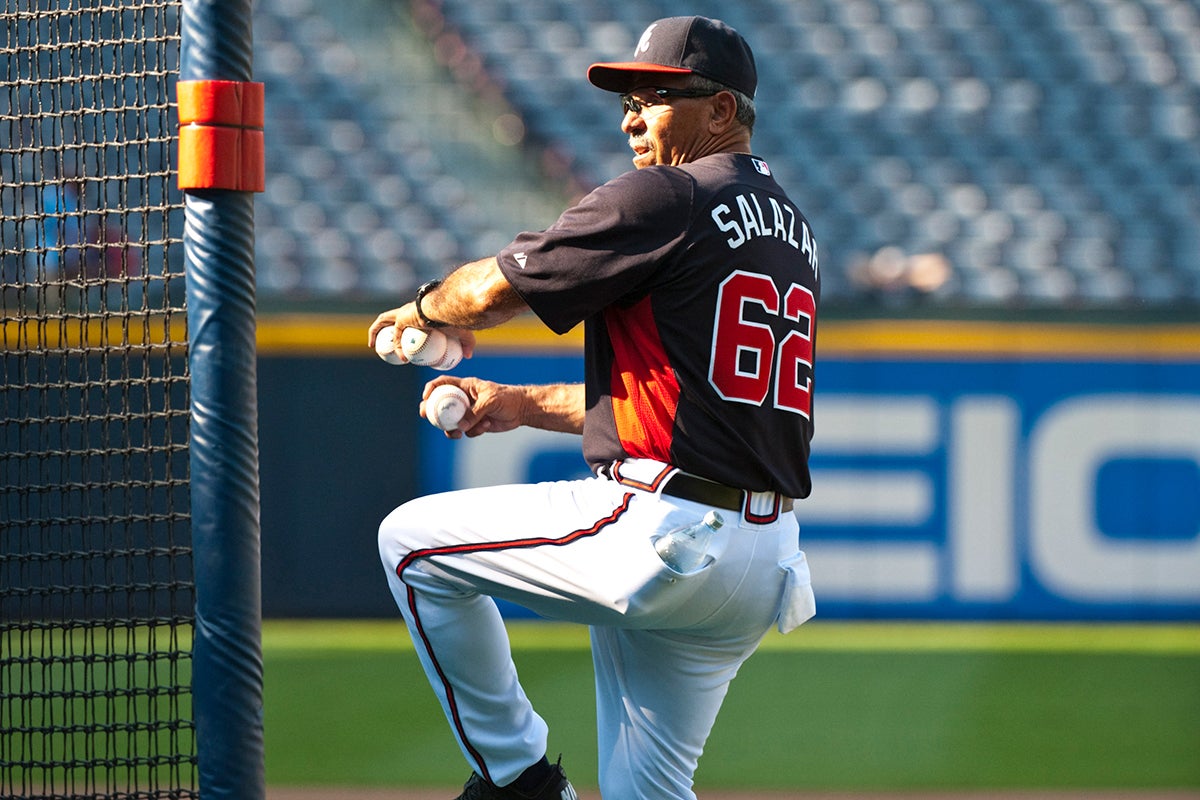
On March 9, 2011, Salazar was standing near the dugout during a Spring Training game against the Cardinals at Champion Stadium in Orlando, Fla., when Braves catcher Brian McCann ripped a line drive that hit Salazar flush on the left side of his face. Team medical personnel worked to keep Salazar alive before he was transported to nearby Orlando Regional Medical Center, where he was treated for multiple facial fractures and a broken right arm suffered when he fell from the dugout steps after being struck. He would lose his left eye due to the accident.
Salazar returned to manage the Lynchburg Hillcats early in the 2011 season, working with a bandage over his left eye before receiving a prosthetic one.
Late in the 2011 season, the Braves brought Salazar to Atlanta to help coach the big league team.
“He told me he’s a stronger person now that he’s gone through this,” McCann told the Atlanta Journal-Constitution in September of 2011. “That’s what makes him so special.”
Salazar managed in the Braves’ system through the 2017 season then spent 2018 skippering the Marlins’ Class A team in Kissimmee, Fla.
Over 13 big league seasons as a player, Salazar hit .261 with 1,070 hits and 117 stolen bases in 1,302 games. He also played 18 seasons for La Guaira Sharks in the Venezuelan Winter League, and his uniform number was eventually retired by the team.
A baseball lifer, Salazar spent his post-playing career paying forward the lessons he learned when he first came to the United States.
“In the minors, you’re being like a father to these kids,” Salazar said in 2011. “They’re learning about the process of baseball and a little bit here and there about life.”
Craig Muder is the director of communications for the National Baseball Hall of Fame and Museum


